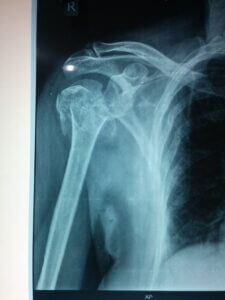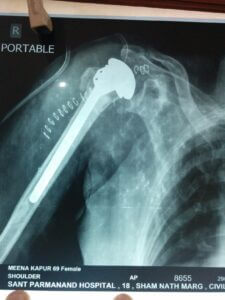Shoulder Hemiarthroplasty
Shoulder Hemiarthroplasty
Shoulder hemiarthroplasty or Partial shoulder is performed mostly in complex fractures of the shoulder where the fracture has multiple fragments which can’t be reconstructed. It’s usually reserved for elderly persons where poor bone quality due to osteoporosis prevents stable fixation of the fracture fragments. In these cases the fractured head is excised and replaced by artificial head which allows quick recovery and return to function.


FAQs by Shoulder Hemiarthroplasty Patients
What is a shoulder Hemiarthroplasty?
A shoulder hemiarthroplasty is a surgical procedure to replace a damaged humeral head with a prosthetic implant. It is commonly used for severe shoulder fractures where the joint surface is extensively damaged. During the surgery, the damaged humeral head is removed and a prosthetic implant is inserted to restore shoulder function and reduce pain. This procedure is often recommended for elderly patients or those who are not suitable for a total shoulder replacement. However, it is important to consult with an orthopedic surgeon to determine if shoulder hemiarthroplasty is appropriate for your condition.
What is the difference between total shoulder arthroplasty and Hemiarthroplasty?
Shoulder joint issues like arthritis or fractures can be fixed with two surgical options: Total Shoulder Arthroplasty (TSA) and Hemiarthroplasty. TSA replaces both the ball and socket with artificial components, providing pain relief and improved mobility for advanced arthritis. Hemiarthroplasty, on the other hand, only replaces the ball and is suitable for fractures. It addresses pain and restores some mobility, but with slightly less range of motion compared to TSA. Considerations for choosing between the two procedures include the extent of the condition, age, activity level, and the surgeon's expertise.
How long does it take to recover from shoulder Hemiarthroplasty?
Shoulder Hemiarthroplasty recovery typically takes 6-12 weeks, but individual recovery times may vary based on factors like age, health, and shoulder damage. Initial weeks post-surgery involve pain and discomfort, requiring physical therapy and rehabilitation to regain strength and functionality. Following surgeon’s instructions and attending regular appointments is crucial for monitoring progress and adjusting the recovery plan. Adherence to the rehabilitation program is key for optimal recovery.
What is range of motion after shoulder Hemiarthroplasty?
Range of motion (ROM) is the extent to which a joint can move. After a shoulder hemiarthroplasty (surgical replacement of the humeral head), ROM can be affected. This procedure is used to treat fractures, arthritis, and rotator cuff tears. Initially, patients have limited ROM due to pain, swelling, and stiffness. Rehabilitation and physiotherapy help improve ROM over time. The expected ROM after surgery varies based on factors like age, health, preoperative ROM, and surgical success. Generally, patients can achieve a functional ROM for daily activities.
